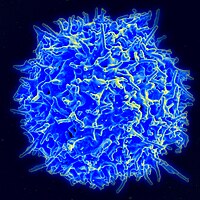
Implications of using classroom response systems (CRS) on learning performance: An experience of learning analytics
Sign Up to like & getrecommendations! Published in 2022 at "Computer Applications in Engineering Education"
DOI: 10.1002/cae.22512
Abstract: The increasing use of technology among new generations of students provides a unique opportunity to take advantage of its multiple benefits in the academic environment. For example, mobile devices can be used in the learning… read more here.
Keywords: crs; classroom response; impact; performance ... See more keywords

Pretransplant active disease status and HLA class II mismatching are associated with increased incidence and severity of cytokine release syndrome after haploidentical transplantation with posttransplant cyclophosphamide
Sign Up to like & getrecommendations! Published in 2019 at "Cancer Medicine"
DOI: 10.1002/cam4.2607
Abstract: Cytokine release syndrome (CRS) represents a life‐threatening side effect after haploidentical stem cell transplantation (Haplo‐SCT) with posttransplant cyclophosphamide (PT‐Cy). Factors predictive of CRS development is still a matter of debate. We retrospectively analyzed 102 consecutive… read more here.
Keywords: disease status; crs; disease; hla ... See more keywords

Fifteen-year survival and conditional survival of women with breast cancer in Osaka, Japan: A population-based study.
Sign Up to like & getrecommendations! Published in 2023 at "Cancer medicine"
DOI: 10.1002/cam4.6016
Abstract: BACKGROUND In recent years, the survival of patients with breast cancer has improved. However, few published studies have a longer than 10-year follow-up. Conditional relative survival (CRS), which is relative survival (RS) of patients who… read more here.
Keywords: year; survival; breast cancer; crs ... See more keywords

Cytokine release syndrome after allogeneic stem cell transplantation with posttransplant cyclophosphamide
Sign Up to like & getrecommendations! Published in 2020 at "Hematological Oncology"
DOI: 10.1002/hon.2772
Abstract: Cytokine release syndrome (CRS) is a systemic inflammatory response with aberrant immune activation and immune hyperstimulation, that leads to increased cytokine levels and inflammation. CRS has been described after antibody and cellular‐based therapies. The use… read more here.
Keywords: cytokine release; crs; hsct; release syndrome ... See more keywords

Conditional relative survival in nonmetastatic esophagogastric cancer between 2006 and 2020: A population‐based study
Sign Up to like & getrecommendations! Published in 2023 at "International Journal of Cancer"
DOI: 10.1002/ijc.34480
Abstract: Conditional relative survival (CRS) is useful for communicating prognosis to patients as it provides an estimate of the life expectancy after having survived a certain time after treatment. Our study estimates the 3‐year relative survival… read more here.
Keywords: gastric cancer; relative survival; crs; cancer ... See more keywords

LETTER TO THE EDITOR
Sign Up to like & getrecommendations! Published in 2018 at "Journal of Surgical Oncology"
DOI: 10.1002/jso.24958
Abstract: I have read the article entitled “Is Ethmoidal Air Cell Count Relevant in Chronic Rhinosinusitis?” with great interest. Main idea of the article is based on the knowledge that increased septation of the ethmoid could… read more here.
Keywords: crs; pathogenesis; cell count; crs groups ... See more keywords

Outcomes of neoadjuvant chemotherapy before CRS‐HIPEC for patients with appendiceal cancer
Sign Up to like & getrecommendations! Published in 2020 at "Journal of Surgical Oncology"
DOI: 10.1002/jso.25967
Abstract: Cytoreductive surgery (CRS) with or without hyperthermic intraperitoneal chemotherapy (HIPEC) is indicated for patients with peritoneal dissemination of appendiceal cancer. The role of neoadjuvant chemotherapy (NAC) before CRS‐HIPEC remains controversial. read more here.
Keywords: chemotherapy; crs; appendiceal cancer; neoadjuvant chemotherapy ... See more keywords

Invited commentary: Author's response to “CRS and HIPEC: Best model of antifragility in surgical oncology”
Sign Up to like & getrecommendations! Published in 2022 at "Journal of Surgical Oncology"
DOI: 10.1002/jso.26904
Abstract: I appreciate the commentary from Souadka et al. regarding our manuscript evaluating the potential benefit of hyperthermic intraperitoneal chemotherapy (HIPEC) for cases of incomplete cytoredu-cion. 1 Addressing the questions raised in the commentary the first… read more here.
Keywords: oncology; cytoreduction; surgical oncology; crs ... See more keywords

[Perioperative management for CRS and HIPEC : Anesthesiological aspects].
Sign Up to like & getrecommendations! Published in 2019 at "Der Anaesthesist"
DOI: 10.1007/s00101-019-00706-4
Abstract: Cytoreductive surgery (CRS) and hyperthermic intraperitoneal chemotherapy (HIPEC) are therapeutic options for the treatment of intra-abdominal neoplasms. Following the resection of all visible tumor areas by CRS, microscopic tumor areas are treated with HIPEC. This procedure increases… read more here.
Keywords: management crs; hipec anesthesiological; crs; hipec ... See more keywords

Different effects of allergic rhinitis on nasal mucosa remodeling in chronic rhinosinusitis with and without nasal polyps
Sign Up to like & getrecommendations! Published in 2018 at "European Archives of Oto-Rhino-Laryngology"
DOI: 10.1007/s00405-018-5195-x
Abstract: BackgroundAllergic rhinitis (AR) has been reported to be associated with chronic rhinosinusitis (CRS). The objective of this study was to investigate the effect of AR on nasal mucosa remodeling in CRS.MethodsPatients were enrolled and divided… read more here.
Keywords: rhinitis; nasal mucosa; mucosa remodeling; crs ... See more keywords
The SNOT-22 factorial structure in European patients with chronic rhinosinusitis: new clinical insights
Sign Up to like & getrecommendations! Published in 2019 at "European Archives of Oto-Rhino-Laryngology"
DOI: 10.1007/s00405-019-05320-z
Abstract: PurposeThe sino-nasal outcomes test-22 (SNOT-22) represents the reference questionnaire to assess patients with chronic rhinosinusitis (CRS). As weak correlations between objective CRS parameters and SNOT-22 total score have been observed, factor analyses have aimed to… read more here.
Keywords: factor; score; crs; item domain ... See more keywords